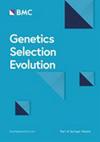培育育成猪的抗逆性可减少咬尾、跛足和死亡率
IF 3.1
1区 农林科学
Q1 AGRICULTURE, DAIRY & ANIMAL SCIENCE
引用次数: 0
摘要
以往的研究表明,纵向数据中的偏差具有遗传性,可作为猪的一般抗逆性的代表。然而,只有少数研究调查了这些恢复力特征与其他与恢复力和福利相关的特征之间的关系。因此,本研究调查了从纵向数据偏差中得出的恢复力性状与动物恢复力、健康和福利相关性状(如咬尾和咬耳伤、跛足和死亡率)之间的关系。在我们的实验中,我们每两周对 1919 头已知血统的育成猪(133 头皮耶特兰公猪和 266 头杂交母猪)进行称重,并对跛行、咬耳和咬尾伤口等身体异常情况进行评分(17066 条记录)。通过体重偏差、称重顺序偏差和称重时观察到的活动偏差来评估抗逆性。研究了这些恢复力特征与身体异常特征之间的关联,并估算了遗传参数。体重偏差的遗传率估计值为中等(h2 = 25.2% 至 36.3%),而称重顺序偏差(h2 = 4.2%)和称重时活动偏差(h2 = 12.0%)的遗传率估计值较低。此外,体重偏差与咬尾伤(rg = 0.22 至 0.30)、跛足(rg = 0.15 至 0.31)和死亡率(rg = 0.19 至 0.33)呈正相关,并与遗传相关。这些结果表明,咬尾、跛足和死亡事件与猪的体重变化偏差有关。而称重顺序和称重过程中的活动偏差则不存在这种关系。此外,个体体重偏差与栏内均匀度呈正相关,这证明了针对这些抗逆性特质进行育种可能会提高猪的抗逆性和户内均匀度。总之,我们的研究结果表明,根据纵向体重数据的偏差进行抗逆性育种,可以减少猪的咬尾伤、跛足和死亡率,同时提高栏内的均匀度。这些发现对养猪业者很有价值,因为它们提供了证据,证明这些恢复力特征是动物总体健康、福利和恢复力的指标。此外,这些结果将促进通过纵向体重对其他物种的恢复力进行量化。本文章由计算机程序翻译,如有差异,请以英文原文为准。
Breeding for resilience in finishing pigs can decrease tail biting, lameness and mortality
Previous research showed that deviations in longitudinal data are heritable and can be used as a proxy for pigs’ general resilience. However, only a few studies investigated the relationship between these resilience traits and other traits related to resilience and welfare. Therefore, this study investigated the relationship between resilience traits derived from deviations in longitudinal data and traits related to animal resilience, health and welfare, such as tail and ear biting wounds, lameness and mortality. In our experiment, 1919 finishing pigs with known pedigree (133 Piétrain sires and 266 crossbred dams) were weighed every 2 weeks and scored for physical abnormalities, such as lameness and ear and tail biting wounds (17,066 records). Resilience was assessed via deviations in body weight, deviations in weighing order and deviations in observed activity during weighing. The association between these resilience traits and physical abnormality traits was investigated and genetic parameters were estimated. Deviations in body weight had moderate heritability estimates (h2 = 25.2 to 36.3%), whereas deviations in weighing order (h2 = 4.2%) and deviations in activity during weighing (h2 = 12.0%) had low heritability estimates. Moreover, deviations in body weight were positively associated and genetically correlated with tail biting wounds (rg = 0.22 to 0.30), lameness (rg = 0.15 to 0.31) and mortality (rg = 0.19 to 0.33). These results indicate that events of tail biting, lameness and mortality are associated with deviations in pigs’ body weight evolution. This relationship was not found for deviations in weighing order and activity during weighing. Furthermore, individual body weight deviations were positively correlated with uniformity at the pen level, providing evidence that breeding for these resilience traits might increase both pigs’ resilience and within-family uniformity. In summary, our findings show that breeding for resilience traits based on deviations in longitudinal weight data can decrease pigs’ tail biting wounds, lameness and mortality while improving uniformity at the pen level. These findings are valuable for pig breeders, as they offer evidence that these resilience traits are an indication of animals’ general health, welfare and resilience. Moreover, these results will stimulate the quantification of resilience via longitudinal body weights in other species.
求助全文
通过发布文献求助,成功后即可免费获取论文全文。
去求助
来源期刊

Genetics Selection Evolution
生物-奶制品与动物科学
CiteScore
6.50
自引率
9.80%
发文量
74
审稿时长
1 months
期刊介绍:
Genetics Selection Evolution invites basic, applied and methodological content that will aid the current understanding and the utilization of genetic variability in domestic animal species. Although the focus is on domestic animal species, research on other species is invited if it contributes to the understanding of the use of genetic variability in domestic animals. Genetics Selection Evolution publishes results from all levels of study, from the gene to the quantitative trait, from the individual to the population, the breed or the species. Contributions concerning both the biological approach, from molecular genetics to quantitative genetics, as well as the mathematical approach, from population genetics to statistics, are welcome. Specific areas of interest include but are not limited to: gene and QTL identification, mapping and characterization, analysis of new phenotypes, high-throughput SNP data analysis, functional genomics, cytogenetics, genetic diversity of populations and breeds, genetic evaluation, applied and experimental selection, genomic selection, selection efficiency, and statistical methodology for the genetic analysis of phenotypes with quantitative and mixed inheritance.
 求助内容:
求助内容: 应助结果提醒方式:
应助结果提醒方式:


